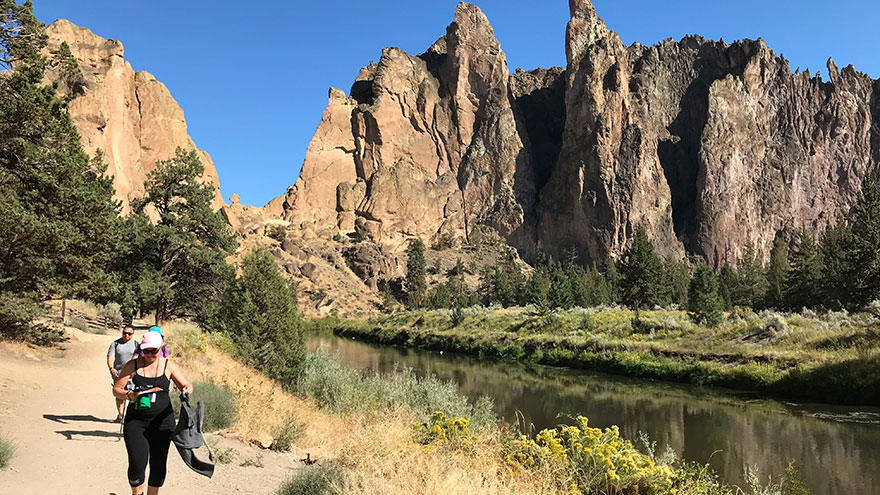Hiking in Smith Rock State Park
Smith Rock State Park, set amid central Oregon’s high desert plateau, is known by avid rock climbers for its thousands of climbing routes, more than 1,000 of which are already bolted.
To get to many of those climbs, however, you must use the park’s system of trails, which wind through and around a deep river canyon, and provide hikers with the chance to glimpse wildlife such as beaver, mule deer, river otters, bald eagles, golden eagles and prairie falcons.

Planning Your Trip
To hike in Smith Rock State Park, you must pay a small day-use fee, although one-year and two-year passes are available at discounted rates. The park, open year-round, annually averages more than 480,000 day-use visitors. The best times for hiking at Smith Rock are spring and fall, when high temperatures range from the high-50s to mid-70s Fahrenheit.
Average highs in July and August can reach the 80s and above, with typical winter highs in the 40s. Early-morning and late-afternoon temperatures typically dip into the 40s even in summer — and into the 30s in spring and fall — so take several layers of clothing, along with plenty of water and sunscreen. The park’s website provides daily weather reports plus updates on hiking and climbing conditions.
Hiking Trails
Smith Rock State Park has 11 marked trails that add up to slightly more than 12 miles. Several trails connect to one another, allowing hikers to choose from longer or shorter treks. The park’s longest trails are the Summit and River trails, each 2.5 miles one way. The River Trail starts at a footbridge that crosses the Crooked River, and follows the river’s bends deep in the canyon before connecting to the Summit Trail, which ascends the bluffs, reaches elevations of 3,400 feet and provides scenic canyon views.
For a shorter hike, choose the Rim Rock Trail, a half-mile loop near the park’s entrance, or combine the 500-foot Chute, which starts near the day-use parking area, with the 1-mile Homestead Trail along the river. Some trails are open to mountain bikers and equestrians.
Hiking/Climbing Combos
If you’d like to combine a hike with a rock climb at Smith Rock State Park, the park’s Misery Ridge Trail is only two-thirds of a mile but leads to two of the park’s primary climbing destinations: Monkey Face, a challenging 350-foot-tall spire with several routes to the top, and the Red Wall, which offers a 300-foot climb with a variety of natural features such as slabs and wide cracks.
Other trails lead to climbing spots with interesting monikers such as Morning Glory, the Dihedrals, and Christian Brothers (all near the River Trail), and First Kiss (Mesa Verde Trail). Local companies provide climbing instruction and guided climbing excursions into the park for all ages and levels.
Other Park Amenities
In addition to hiking and rock climbing, Smith Rock State Park has a number of other amenities and attractions, including fishing in the Crooked River, a welcome center, native plant garden and picnic areas. If you’d like to stay overnight, the park has a walk-in bivouac camping area with dozens of campsites for tents only.
The campground has community restrooms with hot showers, but campfires are prohibited because of the desert’s typical dry conditions. If you’d rather stay indoors, the city of Redmond, approximately 9 miles southwest of the park, has a number of lodging options.

